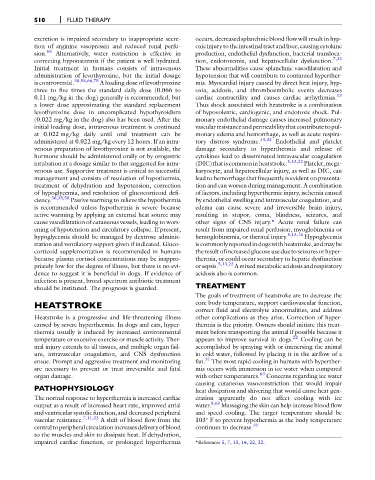Page 522 - Fluid, Electrolyte, and Acid-Base Disorders in Small Animal Practice
P. 522
510 FLUID THERAPY
excretion is impaired secondary to inappropriate secre- occurs, decreased splanchnic blood flow will result in hyp-
tion of arginine vasopressin and reduced renal perfu- oxicinjurytotheintestinaltract andliver,causingcytokine
sion. 58 Alternatively, water restriction is effective in production, endothelial dysfunction, bacterial transloca-
correcting hyponatremia if the patient is well hydrated. tion, endotoxemia, and hepatocellular dysfunction. 7,32
Initial treatment in humans consists of intravenous These abnormalities cause splanchnic vasodilatation and
administration of levothyroxine, but the initial dosage hypotension that will contribute to continued hyperther-
is controversial. 38,58,66,78 A loading dose of levothyroxine mia. Myocardial injury caused by direct heat injury, hyp-
three to five times the standard daily dose (0.066 to oxia, acidosis, and thromboembolic events decreases
0.11 mg/kg in the dog) generally is recommended, but cardiac contractility and causes cardiac arrhythmias. 13
a lower dose approximating the standard replacement Thus shock associated with heatstroke is a combination
levothyroxine dose in uncomplicated hypothyroidism of hypovolemic, cardiogenic, and endotoxic shock. Pul-
(0.022 mg/kg in the dog) also has been used. After the monary endothelial damage causes increased pulmonary
initial loading dose, intravenous treatment is continued vascular resistanceandpermeabilitythatcontributetopul-
at 0.022 mg/kg daily until oral treatment can be monary edema and hemorrhage, as well as acute respira-
administered at 0.022 mg/kg every 12 hours. If an intra- tory distress syndrome. 14,32 Endothelial and platelet
venous preparation of levothyroxine is not available, the damage secondary to hyperthermia and release of
hormone should be administered orally or by orogastric cytokines lead to disseminated intravascular coagulation
intubation at a dosage similar to that suggested for intra- (DIC) thatiscommon inheatstroke. 5,13,22 Platelet,mega-
venous use. Supportive treatment is critical to successful karyocyte, and hepatocellular injury, as well as DIC, can
management and consists of resolution of hypothermia, lead to hemorrhage that frequently is evident on presenta-
treatment of dehydration and hypotension, correction tion and can worsen during management. A combination
of hypoglycemia, and resolution of glucocorticoid defi- of factors, including hyperthermic injury, ischemia caused
ciency. 36,38,58 Passive warming to relieve the hypothermia by endothelial swelling and intravascular coagulation, and
is recommended unless hypothermia is severe because edema can cause severe and irreversible brain injury,
active warming by applying an external heat source may resulting in stupor, coma, blindness, seizures, and
cause vasodilatation of cutaneous vessels, leading to wors- other signs of CNS injury.* Acute renal failure can
ening of hypotension and circulatory collapse. If present, result from impaired renal perfusion, myoglobinemia or
hypoglycemia should be managed by dextrose adminis- hemoglobinemia, or thermal injury. 5,13,14 Hypoglycemia
tration and ventilatory support given if indicated. Gluco- is commonly reported in dogs with heatstroke, and may be
corticoid supplementation is recommended in humans theresult ofincreasedglucoseuseduetoseizures orhyper-
because plasma cortisol concentrations may be inappro- thermia, or could occur secondary to hepatic dysfunction
priately low for the degree of illness, but there is no evi- orsepsis. 5,13,22 A mixed metabolic acidosis and respiratory
dence to suggest it is beneficial in dogs. If evidence of acidosis also is common.
infection is present, broad-spectrum antibiotic treatment
should be instituted. The prognosis is guarded. TREATMENT
The goals of treatment of heatstroke are to decrease the
HEATSTROKE core body temperature, support cardiovascular function,
correct fluid and electrolyte abnormalities, and address
Heatstroke is a progressive and life-threatening illness other complications as they arise. Correction of hyper-
caused by severe hyperthermia. In dogs and cats, hyper- thermia is the priority. Owners should initiate this treat-
thermia usually is induced by increased environmental ment before transporting the animal if possible because it
temperature or excessive exercise or muscle activity. Ther- appears to improve survival in dogs. 22 Cooling can be
mal injury extends to all tissues, and multiple organ fail- accomplished by spraying with or immersing the animal
ure, intravascular coagulation, and CNS dysfunction in cold water, followed by placing it in the airflow of a
ensue. Prompt and aggressive treatment and monitoring fan. 31 The most rapid cooling in humans with hyperther-
are necessary to prevent or treat irreversible and fatal mia occurs with immersion in ice water when compared
organ damage. with other temperatures. 63 Concerns regarding ice water
causing cutaneous vasoconstriction that would impair
PATHOPHYSIOLOGY heat dissipation and shivering that would cause heat gen-
The normal response to hyperthermia is increased cardiac eration apparently do not affect cooling with ice
output as a result of increased heart rate, improved atrial water. 8,63 Massaging the skin can help increase blood flow
and ventricular systolic function, and decreased peripheral and speed cooling. The target temperature should be
vascular resistance. 7,11,32 A shift of blood flow from the 103 F to prevent hypothermia as the body temperature
central toperipheral circulation increases delivery ofblood continues to decrease. 31
to the muscles and skin to dissipate heat. If dehydration,
impaired cardiac function, or prolonged hyperthermia *References 5, 7, 13, 14, 22, 32.

